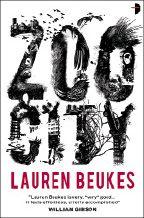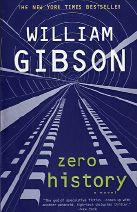Science Fiction: The 101 Best Novels 1985-2010 (53 page)
Read Science Fiction: The 101 Best Novels 1985-2010 Online
Authors: Damien Broderick,Paul di Filippo

99
Lauren Beukes
(2010)

SCIENCE FICTION
is the literature of change, yes indeed. But by this maxim, the genre reader generally understands an incremental, if-this-goes-on type of change. Even stories set ten millennia into the future presuppose a steady drumbeat of historical stepping-stone changes, one neatly following another, even if there are periods of “two steps forward, one step back,” or vice versa. There are variations to this algorithm, of course, involving unexpected but nonetheless conceivable changes. Suppose cheap fusion power were perfected. Then society would change radically, but still along comprehensible lines. Or suppose Armageddon arrived, via alien invasion or human folly. A massive, catastrophic change, but, again, with predictable lineaments. Black swans are a given.
Yet from time to time sf contemplates what might be best dubbed “paradigm shifts,” incredible, unforeseeable alterations in the very functioning of the universe. In Poul Anderson’s
Brain Wave
, the Earth swims into a different cosmic zone, and brain functioning accelerates for every creature on the planet. In Jack Vance’s “The Men Return,” the narrative opens in the long-established aftermath of such a quantum change, and we witness the transition back to “normality.” Greg Egan’s “Luminous” postulates a rival region of space whose alien mathematics threatens to swamp our precarious habitat. Sometimes, new branches of science retroactively warp the consensus history we take for granted. In both Ian MacLeod’s The Light Ages and The House of Storms (Entry 78) and Stephen Baxter’s Anti-Ice, strange substances—aether and anti-ice—thrust our continuum down orthogonal paths.
Such is the case with Lauren Beukes’s Clarke Award-winning
Zoo City
, a fit companion to the MacLeod and Baxter volumes. Beukes’s second novel, after the well-received
Moxyland
, is set in a Johannesburg, South Africa, circa 2009, that is both familiar and estranged.
“Zoo City” is the nickname given the Hillbrow inner residential district of Johannesburg. Here live citizens of an underclass dubbed the “animalled,” people who have been saddled with totem beasts, mystical yet tangible icons of their “sins.” (A textual wink toward Philip Pullman’s use of this conceit in the
His Dark Materials
sequence is sure to provoke a smile.) The animalled began massively manifesting globally in the late 1990s, but retrospectively could be detected as early as 1986. Their appearance marked the Ontological Shift, which has allowed “magic” entry into the world. The animalled humans each receive a
shavi
, or power, as compensation for their ostracism. But these powers actually read more like the genre-honored psi capabilities beloved of John Campbell & Co. And in fact Beukes has a go at explaining them with science: “Lab studies show that some spells work through manipulating hormone levels, boosting serotonin or oxytocin or testosterone.”
Our juicy-voiced, dirty-mouthed, metaphor-slinging narrator and heroine is one Zinzi December, attached to an affable Sloth for the murder of her brother. Zinzi’s wild talent is a form of psychometry, the ability to mentally discern links and histories between objects and people. Zinzi has cobbled together a dicey, dead-end, off-the-books living by selling her talent for petty quests—finding lost wedding rings, etc.—and by using her old journalistic skills—from her “Former Life”—to pen spammer scams. But then she is hired by a rich and powerful music producer, Odi Huron, to find a missing young female pop star named Songweza. This MacGuffin propels her and us through a rich assortment of places and peoples and incidents, accreting a palpable vision of this recalibrated world.
A native of South Africa, Beukes pumps her novel full of that continent’s manifold cultures, miseries, joys and sensory riches. This hybrid techno-magical milieu is as colorful as African textiles, as noisy and dangerous as a liquor-sodden shebeen, as rhythmic and melodious as the Kwaito music Songweza sings. Departing from the polar opposite literary images of Africa as either a continent of failed states or a repository of mythic nobility, Beuke’s portrait of this lateral continuum establishes Africa as its own heterogeneous sovereign entity, on an equal footing with the First World.
Beukes’s novel has been hailed as another fine instance of noir sf, but if so, her noir is not that of Chandler or Hammett which William Gibson embraced. Rather, Zinzi’s telling and attitude hark back to one of the other top crime writers, Ross MacDonald, and his PI, Lew Archer. MacDonald’s focus on families and their secrets is replicated in Zinzi’s delvings into the brother-sister bonds between Songweza and S’bu, and the
in loco parentis
misdeeds of Huron. And her tropical Johannesburg maps surprisingly well onto MacDonald’s sun-addled, superficial California. “The urban sprawl thins out as the road deteriorates; kit-model cluster homes, malls and the fake Italian maestro-work that is the casino give way to B&Bs, stables, ironwork furniture factories, and country restaurants.” Kitsch and brand-names and slovenly construction are the uniform surface of the world, even where magic prevails.
On the sf tip, Beukes’s personable familiars tap into the same mythic and fan-pleasing vein as Andre Norton’s The Beast Master and James Schmitz’s The Demon Breed. Humanity’s long dream of a deeper consortium with the rest of unspeaking biological creation is a perennial sf trope. Her exfoliation of how the Ontological Shift would be integrated into society is blueprint-precise (hospitals have special procedures for magical animal bites). And her climax involving perversions of the shavi powers and animal familiars could only arise in the new paradigm she has invented.
The animalled ones fear a kind of dark matter of the soul they call the Undertow. By confronting this fearlessly, Zinzi December proves that the only way to emerge out the far side of any change is by moving relentlessly forward.
100
William Gibson
(2010)

LIKE
SOME
arcane and cryptic wizard employing a hieratic numerology to craft his spells, William Gibson likes to work in threes. Far from being impelled by the publishing industry’s fascination with commercial trilogies—for, indeed, his triplets are not even marketed as such, but only observed in retrospect—Gibson’s focus on sequential cycles of three novels seems to arise from his need to employ shifting angles of attack, to make lateral feints and forays against and into his abstruse subject matter.
His most famous set of three books probably remains his first:
Neuromancer
,
Count Zero
and
Mona Lisa Overdrive
, the “Sprawl” trilogy that introduced cyberpunk and cyberspace to the reading public. Following a story collection and a collaborative steampunk novel, Gibson next turned his attention closer to the present with the “Bridge” trilogy:
Virtual Light
,
Idoru
, and
All Tomorrow’s Parties
.
Zero History
marks the culmination of a trilogy too new to have been named yet (although by this chapter’s end, an overarching appellation suggests itself), a cycle that started with
Pattern Recognition
and continued with
Spook Country
. All three books are set in a recognizable present, Gibson having foresworn traditional sf with the assertion that “fully imagined cultural futures were the luxury of another day....” Some critics have dubbed this new mode of storytelling “speculative fiction of the very recent past.”
And truly, the bones beneath the narrative flesh are remarkably similar. Still following sf’s imperative to dramatize cultural, political and technological changes in visionary ways, Gibson’s newest fiction slides a reality-enhancement filter over his authorial camera lens, offering snapshots of contemporary times that are more CAT scans than photographs, totalizing in a diagnostic readout where the estranging and deracinating forces at play all around us—a sustaining yet potentially poisonous memetic medium we swim in, and consequently ignore—are highlighted and brought into the foreground of the reader’s attention.
Consider Gibson’s current fiction as analogous to the controversial terahertz body scanners being installed at airports worldwide: they both present ghostly yet detailed and embarrassing imagery of the hidden aspects of whatever passes before their eye.
Pattern Recognition
(2003) featured a female protagonist, Cayce Pollard, who possessed an almost supernatural sensitivity toward commercial hype. A freelancer, she was hired to track down, among other things, the origin of some viral video being posted on the internet. But the man who did the hiring—Hubertus Bigend, millionaire owner of a firm called Blue Ant—although he was onscreen only minimally in that first outing, would become the dominant figure of the next two books, just as Cayce would be replaced by a new model heroine. Gibson’s rethinking and retooling at work.
The enigmatic Bigend is a relatively young and charismatic Belgian whose name is pronounced “bay-jend,” although he self-mockingly accepts and encourages the easy and common mispronunciation of “Big End.” Money and fame are secondary to him, if not ultimately undesirable. What really floats his boat is surfing the wavefronts of trends and innovations, of winkling out potential new cultural explosions while they are still sputtering squibs. He is, in essence, the ultimate coolhunter, and tends to employ people possessing similar gifts. Curiously, Cory Doctorow’s recent
Makers
features a very similar mover and shaker, Landon “Kettlebelly” Kettlewell, leading a reader to ponder exactly why that archetype is assuming greater prominence in today’s culture.
In
Spook Country
(2007), Bigend employs Hollis Henry, female ex-member of an eccentric pop group called the Curfew. He sets her on the trail of what, at the time of the book’s publication, was called “locative art,” but which today has been subsumed under the broader heading of “augmented reality.” Parallel to Hollis’s strand is that of a clever and sensitive drug addict named Milgrim, co-opted by the Feds and sent after some mysterious people who might be terrorists, but who turn out to be principled avengers of wrong-doing. One of these fellows is named Garreth, and he becomes Hollis’s lover.
Zero History
opens up about a year or so later. Hollis and Milgrim, relocated to London from the USA, continue to work for Bigend. The utterly believable and easy-to-love Hollis remains essentially the woman we came to know in
Spook Country
: a wry, savvy, wary and principled artist and survivor. She’s a nicer version of Cassandra Nearing, ex-punk photographer from Elizabeth Hand’s
Generation Loss
(2007).
But Milgrim has undergone a rejuvenation, having been detoxed at Bigend’s great expense through an experimental method of multiple total blood replacements. It is Milgrim, in effect, who is starting out at “zero history,” a condition that also echoes much of twenty-first-century existence, as the restless citizenry of the planet seeks to forget or to mashup humanity’s inconvenient past in a fit of “atemporality.” In fact, the ratio of authorial interest and focus has been reversed here from earlier. Whereas in
Spook Country
the storytelling was about sixty-forty in favor of Hollis, here Milgrim’s personality and fate assume dominance. (One might well assume that Milgrim is named after Stanley Milgram, famed psychologist who often seemed intent on stripping down the human psyche to its essential building blocks, much in the way that Gibson’s Milgrim has been rebuilt.)
